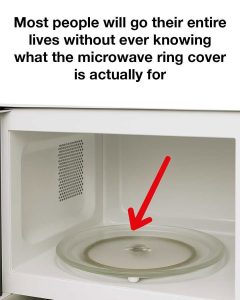The microwave ring cover, a small but essential part of a microwave oven, is often misunderstood or simply ignored by many users. Found beneath the glass turntable inside the microwave, this component may seem unimportant at first glance. However, it plays a critical role in the appliance’s functionality and longevity. Understanding what the microwave ring cover does, how it works, and why it matters can help users get the most out of their microwave and avoid common issues related to poor performance or damage over time. This often-overlooked part is not just a random plastic ring—it’s a key player in ensuring that your microwave works as intended.

The design of the microwave ring cover is simple yet highly effective. It is usually a circular structure made from heat-resistant plastic or similar material, equipped with a few small wheels or rollers that sit underneath the glass turntable. These wheels help the turntable rotate smoothly while evenly supporting the weight of any food placed on it. This rotation is not just for aesthetics; it ensures that the microwave energy is distributed evenly throughout the food. Without this motion, you could end up with a meal that is scorching hot on one side and cold on the other. The ring cover helps prevent such uneven cooking by enabling the consistent turning of the plate, which ensures that microwave energy hits the food from all sides as it spins.
A major reason many people overlook the ring cover is due to a common misconception: they think it’s an unimportant part or simply a protective ring that can be removed or discarded if it becomes dirty or damaged. Some even assume that it’s just packaging material that should have been thrown out upon unpacking the appliance. This misunderstanding can lead to significant issues. Removing the ring cover may seem harmless, but doing so can result in a wobbly turntable, poor cooking performance, and even damage to the turntable motor over time. Additionally, without the support of the ring cover, the turntable may get scratched or grind against the base of the microwave, creating unwanted noise and friction that can further wear down the unit.
When you take a closer look at the microwave ring cover’s purpose, it becomes clear that its role is both mechanical and functional. Its main job is to assist in the steady and smooth rotation of the turntable. This movement is essential for distributing microwave energy evenly, which in turn is vital for cooking or reheating food thoroughly. If the turntable doesn’t spin properly, the microwaves can concentrate on specific areas of the food, leading to hot and cold spots. This uneven heating can not only make your meal unappetizing but may also be a health risk if certain parts of the food remain undercooked. Therefore, the ring cover’s role in rotation directly impacts both the quality and safety of the meals you prepare in the microwave.
But the usefulness of the ring cover doesn’t stop at just helping the turntable spin. It also contributes to the overall performance of the microwave in several other ways. For instance, it acts as a noise buffer. Without the ring cover, the glass turntable might grind against the base of the microwave, creating loud, unpleasant sounds during operation. The wheels on the ring absorb some of this friction, allowing the turntable to glide smoothly and quietly. In addition to noise reduction, the ring cover helps protect the internal components of the microwave from vibrations and shocks. Each time the microwave is in use, the vibrations created by the spinning plate and the movement of food can place stress on internal parts. The ring cover minimizes this stress by absorbing some of the impact, effectively increasing the durability of the appliance over time.
In practical terms, the microwave ring cover serves several essential purposes. First, it guarantees even cooking by keeping the turntable rotating in a smooth, consistent manner. Second, it reduces operational noise by acting as a buffer between the glass and the microwave’s base. Third, it protects the internal components by dampening vibrations and absorbing shocks. Fourth, it helps support the weight of both the turntable and the food, preventing unsteady movement that could result in spills. And finally, it adds to the overall lifespan of the microwave, preserving the condition of both the turntable and the internal motor by reducing wear and tear.
Understanding the significance of this one small component can change how you care for and maintain your microwave. It’s easy to assume that only the major parts—the door, the control panel, the magnetron—really matter. But even something as seemingly minor as a plastic ring with wheels has a big impact on performance. That’s why it’s important to regularly clean the ring cover, inspect it for cracks or wear, and replace it if necessary. A broken or missing wheel can throw off the balance of the turntable, making it spin unevenly or not at all. Keeping the ring cover in good condition is a simple way to ensure your microwave remains in top working order.
In summary, while the microwave ring cover may not grab your attention when you look inside the appliance, its role is vital to how your microwave operates. From enabling even cooking to reducing noise and protecting internal parts, this component supports the microwave’s functionality in more ways than one. By recognizing its importance and treating it with the same care as other parts of the appliance, users can enhance the microwave’s performance and extend its usable life. The next time you clean your microwave or notice a strange noise during operation, don’t overlook the ring cover. It might just be the unsung hero that keeps everything running smoothly.





